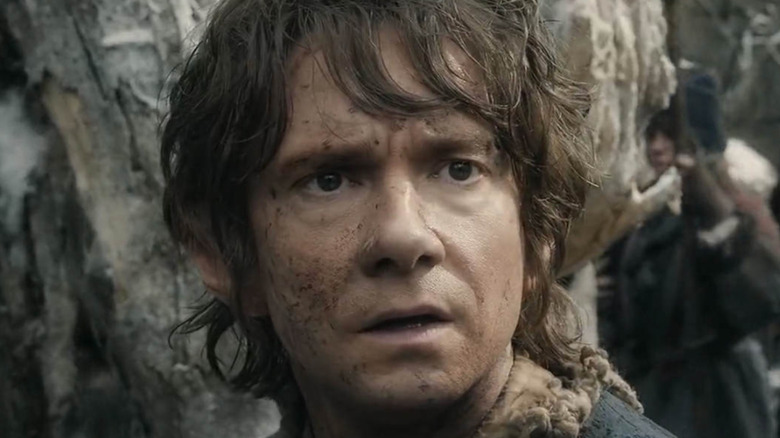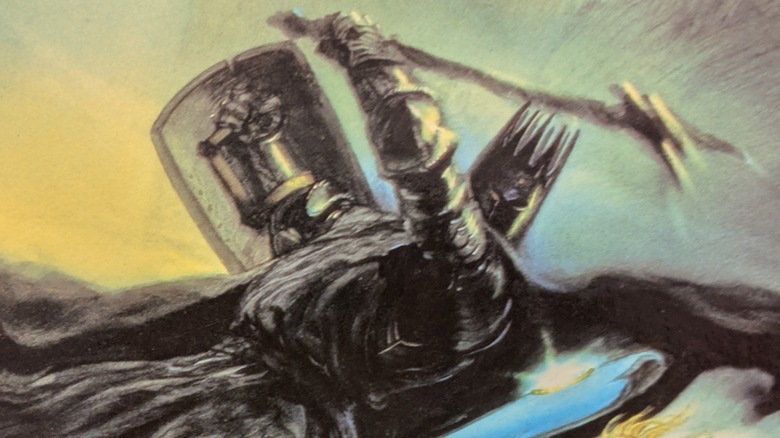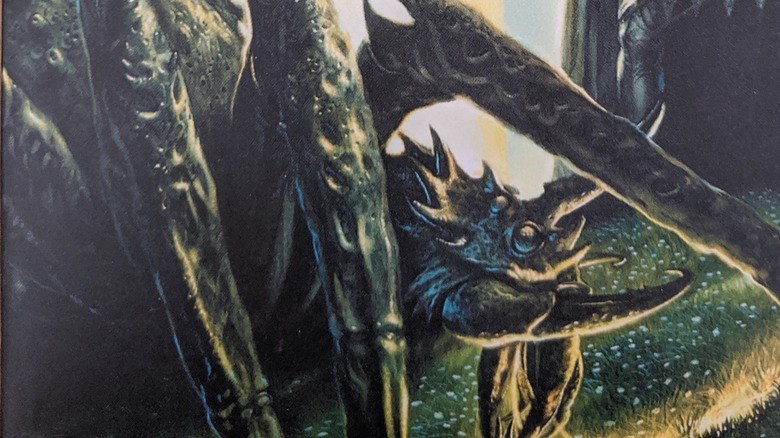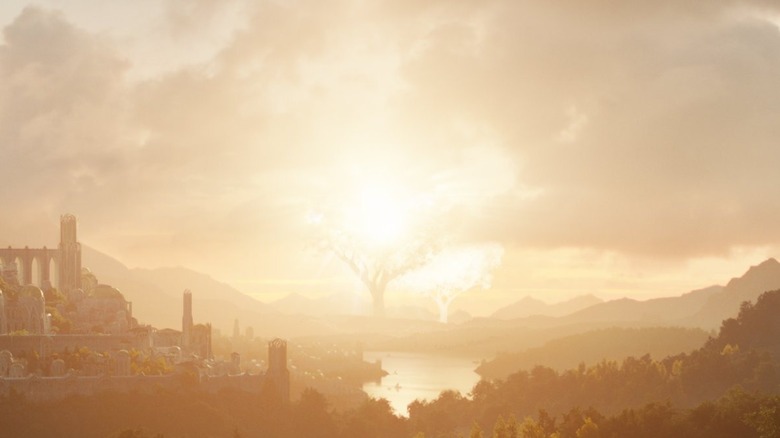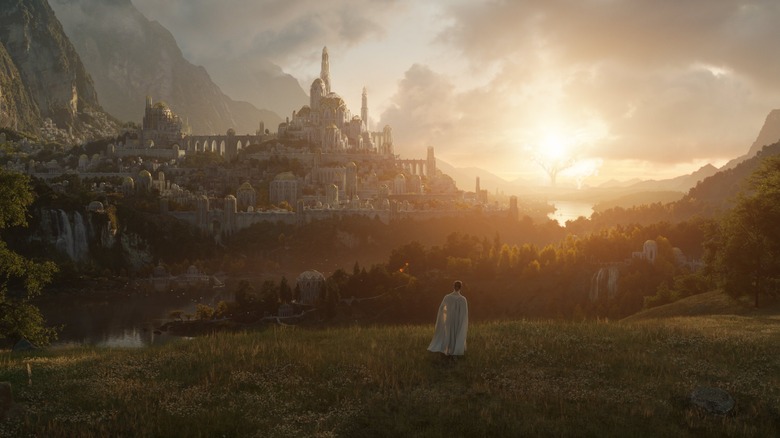Will We See This Epic Pair Of Villains In Amazon's Middle-Earth Show?
Ever since Peter Jackson's award-winning "Lord of the Rings" trilogy was released two decades ago, fans have speculated whether a prequel inspired by "The Silmarillion" was possible. The events of that dense volume start with the creation of the world and work their way up through Middle-earth history, ending with the events of "The Lord of the Rings" at the end of the Third Age.
The problem is, adapting the fantastically complex, time-skipping narrative in "The Silmarillion" would be difficult. It would involve straightening out a convoluted timeline and dealing with an endless barrage of confusing names, places, and events. However, Amazon Studios seems undeterred by this challenge, given the fact that they purchased a portion of the prequel rights in 2017 and have since developed it into a TV show.
In early August 2021, the studio reinforced the hope that this long-gestating series would be worth the wait by releasing the first jaw-dropping image. Not only is the shot gorgeous, but it features two glowing trees in the background. Diehard Tolkien fans quickly connected these trees to the Two Trees of Valinor, which are tied to an early era of Middle-earth history called the Years of the Trees (via Tolkien Gateway).
If the speculation is true, it means at least some of the show will be visiting a period before the First and Second Ages, heading all the way back to a time when the world was young and relatively untroubled. Moreover, if this is the case, there's a chance that Morgoth and Ungoliant, two of the most terrifying villains to ever exist in Middle-earth, will be introduced.
Who are Morgoth and Ungoliant?
Morgoth is the original Dark Lord of Middle-earth. He exists before the creation of the world and descends into the region at the beginning of time along with a host of other angelic spirits called the Ainur (via Tolkien Gateway). Many of these beings remain pure and focused on the task of building the world into something beautiful. However, Morgoth seduces a faction of the Ainur to join him in corrupting the world. One of these beings is the individual who eventually becomes known as Sauron. The rest become Balrogs and other nasty spirits of darkness. Morgoth serves as public enemy number one and the archnemesis of all good beings for the bulk of "The Silmarillion."
While Morgoth is the top villain in Middle-earth, Ungoliant is, in many ways, a worse adversary if only because we know so little about her — except for the fact that she has some terrifying powers. "The Silmarillion" explains that her origin is unknown, but she's a loner who serves no one and lives in a ravine in the south of the world where the shadows are "the deepest and thickest." Ungoliant is a dreadful spirit of unknown power. She's described as a "mistress of her own lust, taking all things to herself to feed her emptiness." She looks like a monstrous spider, and yes, she's also the ancestor of Shelob. Ungoliant can suck up light, with the text saying that she "spun it forth again in dark nets of strangling gloom."
Suffice it to say, both Morgoth and Ungoliant are the kind of baddies that you never want to meet. And yet, each villain on their own doesn't hold a candle to the power they wield when they briefly join forces.
Ungoliant and Morgoth team up in The Silmarillion
Morgoth spends most of "The Silmarillion" at large, commanding huge armies and causing a ruckus. However, there's one chunk of time when he's caught and kept in what amounts to spiritual captivity. This comes after a nifty supernatural episode known as the Battle of the Powers (via Tolkien Gateway). The good Ainur, led by a group called the Valar (via Tolkien Gateway), wages war on Morgoth and captures him in order to protect the newly awakened Elves. When the dust settles, Morgoth is put in spirit-prison. While there, he's left in chains for three ages of the world.
When this lengthy period ends, Morgoth convinces his captors that he's a changed spirit (spoiler: he's not) and is allowed to roam free on parole throughout the Valar's kingdom of the Blessed Realm, a continent located west of Middle-earth (via Tolkien Gateway). It's likely this is the area revealed in Amazon's first image from "The Lord of the Rings."
Now, this is a lot of names and lore, but don't worry. The important thing to remember is that Morgoth is captured, released, and then ends up plotting the destruction of his captors. Eventually, the Dark Lord gets the heck out of dodge, escaping from the Blessed Realm and fleeing to the region of the world where Ungoliant lives. Once they've linked up, Morgoth and Ungoliant make a pact to work together to bring an end to the Blessed Realm.
Morgoth and Ungoliant devastate the Blessed Realm
When Morgoth and Ungoliant officially decide to work together, they know they want to hurt the Valar. But they're not exactly in a superior position at the moment. So, they decide to hit below the belt by striking at their enemies where it will really hurt. Their target? The Two Trees. What are those? As previously mentioned, they may be the two shiny trees seen in Amazon Studio's first released image. Before the sun and moon are created, this magical pair of glowing trees provide light for an entire third of the world and are hallowed by Elves and spirits alike. But — spoiler alert — the Two Trees are destroyed and, from this ruin, comes the sun and moon.
With this pair of arboreal illuminators as their target, Morgoth and Ungoliant pack up and secretly head back to the Blessed Realm, where they plan to cause some serious trouble. As they go along, Ungoliant weaves webs of darkness around herself and Morgoth to stay hidden. Morgoth also plans their arrival for a time when he knows everyone will be away attending an annual festival. This combination of factors enables the duo to attack the Two Trees when no one is expecting it. Morgoth stabs them with a spear, causing their sap to pour out, which then causes his famished arachnid partner to drink them dry. The land goes dark, and the villains high-tail it out of there before they are caught. This sets the rest of the events of "The Silmarillion" in motion.
Neither Morgoth nor Ungoliant makes it to the Second Age, the supposed time period of Amazon's show. Morgoth is imprisoned again, this time without an expiration date. Ungoliant becomes so hungry that she eats herself, which is, well, gross.
Does Amazon's first series image hint at Morgoth and Ungoliant?
Okay, so the story of Morgoth, Ungoliant, and the Two Trees is interesting — or is it just confusing? Maybe both. Anyway, the question we're trying to answer is if Amazon's image teases the destruction of the Two Trees. Before Amazon released the image, the show appeared to focus on the Second Age of Middle-earth history, an era that occurs before "The Lord of the Rings," but it also starts more than 500 years after The Years of the Trees ends. Amazon went so far as to announce this on Twitter in March 2019 when they posted a map and wrote, "Welcome to the Second Age." In other words, they have been talking about a Second Age story for years, and then they go and drop a first-look image that seems to take place hundreds of years before the story they're supposedly covering. The entire situation is a head-scratcher.
Enough has been hinted at through various leaks and rumors to indicate that "The Lord of the Rings" TV show might have access to use this earlier content in some form or another — even if it's just referencing it in a flashback sequence. The only clear thing is that Amazon Studios is keeping its cards pretty close to its chest. Based on how close to the premiere we had to wait to get a Wheel of Time trailer, chances are we won't get a lot of details for the Middle-earth show for many months to come.
Still, if those are the Two Trees and the Blessed Realm in the first series image, it opens up a whole world of possibilities. Best of all, it could mean we get some legit Morgoth and Ungoliant action before all is said and done.
